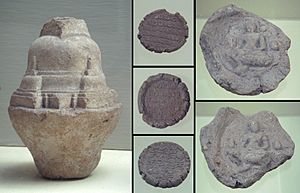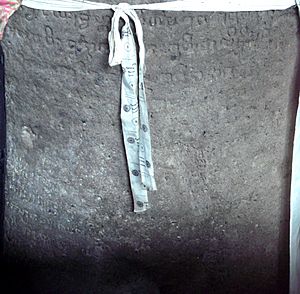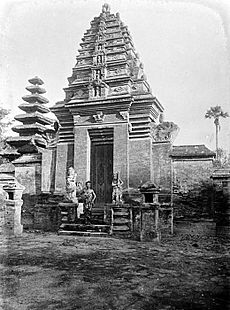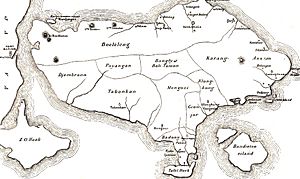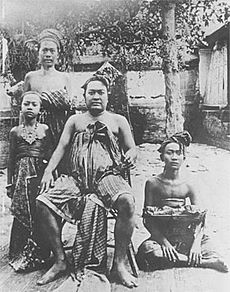Bali Kingdom facts for kids
Quick facts for kids
Kingdom of Bali
Bali Dwipa
|
|||||||||||||
|---|---|---|---|---|---|---|---|---|---|---|---|---|---|
| 914–1908 | |||||||||||||
|
Flag
|
|||||||||||||

The maximum extent of Balinese Kingdom of Gelgel in the mid-16th century
|
|||||||||||||
| Capital |
|
||||||||||||
| Common languages | Kawi language (archaic) Balinese language |
||||||||||||
| Religion | Balinese Hinduism, Mahayana Buddhism | ||||||||||||
| Government | Monarchy | ||||||||||||
| Raja, Arya, Dalem, Dewa Agung | |||||||||||||
|
• c. 914
|
Sri Kesari Warmadewa | ||||||||||||
|
• c. late 10th century
|
Udayana Warmadewa | ||||||||||||
|
• c. early 11th century
|
Anak Wungçu | ||||||||||||
| History | |||||||||||||
|
• Sri Kesari Warmadewa created the Belanjong pillar
|
February 13 or 27 914 | ||||||||||||
|
• Dutch invasion against Klungkung
|
April 18, 1908 | ||||||||||||
| Currency | Native silver coins and Chinese kepeng coins | ||||||||||||
|
|||||||||||||
| Today part of | Indonesia | ||||||||||||
The Kingdom of Bali was a group of Hindu and Buddhist kingdoms that ruled parts of the island of Bali in Indonesia. Balinese kings ruled from the early 900s to the early 1900s.
Their culture was very special. It mixed old Balinese beliefs about spirits and ancestors with Hindu ideas from India. These ideas came to Bali through the island of Java. This mix helped shape the unique Balinese culture.
Bali was very close to Java and often influenced by it. This was especially true during the time of the Hindu-Buddhist kingdoms in Indonesia. Bali's history was linked to powerful Javanese kingdoms like Mataram Kingdom and the Majapahit empire. Java influenced Bali's culture, language, art, and buildings.
When the Majapahit empire fell in the late 1400s, many Hindu nobles, priests, and artists from Java moved to Bali. This made Bali a special place where old Javanese-Hindu culture continued to thrive. Later, Balinese kingdoms even spread their power to nearby islands. For example, the Kingdom of Gelgel ruled parts of eastern Java, Lombok, and even western Sumbawa.
In the mid-1800s, the Dutch East Indies (a Dutch colony) started to get involved in Bali. They fought against the smaller Balinese kingdoms one by one. By the early 1900s, the Dutch had taken control of all of Bali. This ended over a thousand years of Bali's own independent kingdoms. Bali then became part of the Dutch colony, and later, part of the Republic of Indonesia.
Contents
History of Bali's Kingdoms
Ancient Times
Humans have lived in Bali for a very long time, even since the Paleolithic period (about a million years ago). We know this from old tools found in villages like Sembiran. Later, during the Neolithic period (around 3,000 to 600 BCE), the ancestors of today's Balinese people arrived. They started growing rice using special methods like subak and spoke Austronesian languages. After that came the Bronze Age, from about 600 BCE to 800 CE.
First Kingdoms
The written history of Bali began around the 700s. This is when small clay tablets with Buddhist writings were found. These tiny stupa statues, called "stupikas," are the oldest known writings in Bali. They look like the stupas from the 700s in Central Java, like those at Borobudur. This suggests a connection to the Sailendra kingdom in Java.
In the early 900s, a king named Sri Kesari Warmadewa made the Belanjong pillar. This pillar, found near Sanur beach, is the oldest writing in Bali that names a ruler. It is dated 914 CE. Sri Kesari was the first known ruler to use the Warmadewa title. This title was used by Balinese kings for many years.
We don't know exactly where the capital city was back then. But many old discoveries are in the Gianyar Regency. This suggests that the center of the kingdom was there. The famous cave temple Goa Gajah, near Ubud, was built around this time. It shows a mix of Buddhist and Hindu Shivaite art.
Ties with Java
In the late 900s, Bali was ruled by King Udayana Warmadewa and his queen, Mahendradatta. She was a princess from East Java. Having a Javanese queen meant Bali was either allied with East Java or was a part of its kingdom. Their son, Airlangga, became a famous king in Java. His younger brothers, Marakata and Anak Wungçu, later became kings of Bali.
The rock temples of Gunung Kawi in Tampaksiring were built around this time. They look similar to temples from Java's Mataram period. The Warmadewa dynasty ruled Bali until the 1100s. Kings like Jayasakti and Jayapangus were part of this family. Bali also traded with China during this time. Chinese coins, called kepeng, were used a lot in Bali.
Later, Bali became more independent from Java. But in 1284, the Javanese king Kertanegara from Singhasari attacked Bali. Bali became part of Singhasari for a short time. However, after Kertanegara died, Java lost control of Bali.
Java's influence deeply changed the Balinese language. The Kawi language, an old form of Javanese, became very important. It is still used in Bali today, though it is rare.
Majapahit Period
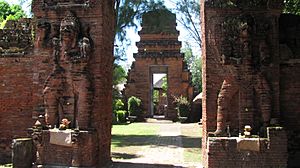
In the 1300s, the powerful Majapahit empire from East Java grew bigger. Its queen, Tribhuwana Wijayatunggadewi, and her strong Prime Minister, Gajah Mada, sent their army to Bali. In 1342, Majapahit troops landed in Bali. After seven months of fighting, they defeated the Balinese king in Bedulu in 1343.
After taking over Bali, Majapahit divided the power among four brothers. Arya Kenceng and his brothers ruled Bali under Majapahit. Arya Kenceng became the ancestor of many Balinese royal families.
The Majapahit capital in Bali was first in Samprangan and later in Gelgel. After the Majapahit empire started to decline in the late 1300s, Bali became more independent again.
In the late 1400s, Majapahit faced internal wars and the rise of the Demak Sultanate, a Muslim kingdom in Java. Many Hindu nobles, artists, and priests from Majapahit fled to Bali. They wanted to avoid the new Muslim rulers. This made Bali a safe place for Hindu Javanese culture.
The arrival of these Javanese people changed Bali a lot. They brought new ideas about religion and art. The Javanese language also influenced the Balinese language. Many old Majapahit writings, like the Nagarakretagama, were kept safe in Bali. This is why Bali is so important for understanding old Javanese-Hindu culture today.
Kingdom of Gelgel
After Majapahit conquered Bali, they set up a new ruling family in Samprangan. This happened in the mid-1300s. The first ruler, Sri Aji Kresna Kepakisan, had three sons. The oldest son was not a good ruler. So, his youngest brother, Dalem Ketut, started a new royal center in Gelgel. Gelgel then became the main kingdom.
Europeans first came to Bali in 1512, when Portuguese ships arrived. In 1585, the Portuguese tried to build a fort and trading post, but it failed.
By the 1500s, the Gelgel court became very powerful. King Dalem Baturenggong ruled in the mid-1500s. He welcomed a wise Javanese Hindu priest named Nirartha. Nirartha wrote many important texts that shaped Balinese Hinduism. Gelgel was strongest under Dalem Baturenggong. It controlled Lombok, western Sumbawa, and Blambangan in eastern Java.
Gelgel's power worried the Mataram Sultanate, a Muslim kingdom in Java. Mataram wanted to unite all of Java and spread Islam. In 1639, Mataram attacked Blambangan. Gelgel supported Blambangan to protect itself from Mataram. Blambangan surrendered but soon became independent again. Mataram then focused on its own problems and left Bali alone.
Nine Kingdoms of Bali
After 1651, the Gelgel kingdom started to break apart due to fights within the royal family. In 1686, a new royal center was built in Klungkung. The rulers of Klungkung were called Dewa Agung. But they could not control all of Bali.
Bali split into nine smaller kingdoms: Klungkung, Buleleng, Karangasem, Mengwi, Badung, Tabanan, Gianyar, Bangli, and Jembrana. Each kingdom had its own ruling family and government. However, they all respected Klungkung as the most important kingdom. Most of these kingdoms are now the basis for the different areas (regencies) of Bali today.
For many years, these kingdoms often fought each other. This made relations between them very complex. This situation continued until the Dutch arrived in the 1800s.
Dutch Takeover
Even though Europeans had visited Bali since 1512, they didn't have much power there. In 1597, Dutch ships arrived. In 1601, another Dutch group came. The king of Gelgel sent a letter to the Dutch, allowing them to trade. The Dutch later used this letter to claim control over Bali, even though it was a misunderstanding.
The Dutch East India Company (VOC) was busy trading spices in other parts of Indonesia. They weren't very interested in Bali because it mostly grew rice, not spices. So, Bali's trade was left to Chinese, Arab, and Bugis traders.
However, in the 1800s, the Dutch changed their mind. As their colonial control grew, they wanted Bali. The Dutch army invaded northern Bali in 1846, 1848, and 1849. They finally took control of the northern kingdoms of Buleleng and Jembrana.
In 1894, the Dutch used a rebellion in Sasak (Lombok) as an excuse to conquer Lombok. They supported the Sasak people against the Balinese rulers there. Thousands died, and many Balinese people chose to perform puputan, a ritual of taking their own lives. Lombok and Karangasem became part of the Dutch East Indies. Soon, the kingdoms of Bangli and Gianyar also accepted Dutch rule. But southern Bali kept fighting.
In 1906, the Dutch attacked the southern kingdoms of Badung and Tabanan. They also weakened Klungkung. They used the Balinese tradition of tawan karang (claiming goods from shipwrecks) as an excuse. Finally, in 1908, the Dutch attacked Klungkung. This completed the Dutch takeover of Bali.
Even though some Balinese royal families survived, the Dutch removed their power. This ended centuries of independent Balinese kingdoms. During the Dutch colonial period, the capital of Bali was Singaraja on the northern coast.



